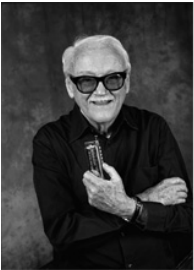|
Toots Thielemans
(April 9, 1922 - August 22, 2016) Jean-Baptiste Frédéric Isidore Thielemans, known to all as Toots, died on Monday, August 22nd, in Brussels, the city of his birth. He was 94. Thielemans began his professional career as a guitar player, and was inspired by Django Reinhardt. In 1949 he joined a jam session in Paris with Sidney Bechet, Charlie Parker, Miles Davis, Max Roach and others. In 1949 and 1950, he participated in European tours with Benny Goodman, making his first record in Stockholm with fellow band member, tenor saxophonist Zoot Sims. He did all this before establishing himself on the instrument for which he was to become most famous: the harmonica. A favorite of jazz musicians worldwide, Toots is less known among the general public, though his harmonica playing is familiar to almost everybody, and can be heard on the soundtracks of movies like “Midnight Cowboy” and “The Getaway.” It was featured in television commercials and on records by, among many others, Ella Fitzgerald, Paul Simon, Billy Joel, Dizzy Gillespie and Quincy Jones, who once called Thielemans “one of the greatest musicians of our time.” And for more than four decades, Toots’s harmonica playing has been heard in the opening theme music of “Sesame Street.” In 1949, Thielemans shared the stage with Charlie Parker at the Paris Jazz Festival, and a year later he toured Europe as the guitarist in a sextet led by Benny Goodman. After moving to the United States in 1951 he eventually became a U.S. citizen. From 1953 to 1959, he was a member of the British jazz pianist George Shearing’s popular quintet. He mostly played guitar with Mr. Shearing, but his harmonica work was featured on at least one number at every performance. It was also showcased on the handful of albums he recorded as a leader in those years. Seacoast jazz fans may recall a performance by Toots Thielemans at UNH some 15 years ago, in a duet with the pianist Kenny Werner. Toots was coming up on 80 years of age at the time, but clearly had a lot of playing left in him. Sources: The New York Times; Wikipedia |
Copyright ©2024 Seacoast Jazz Society, All Rights Reserved


